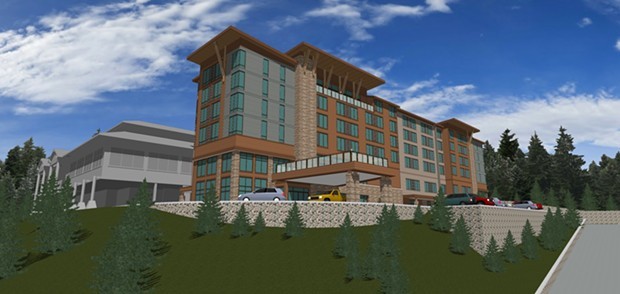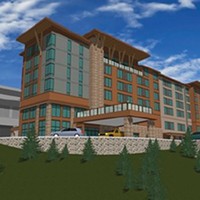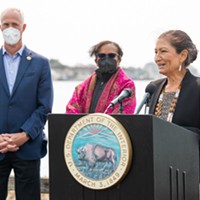
An artistic rendering of the proposed hotel project at Cher-Ae Heights Casino off Scenic Drive south of Trinidad.
[
{
"name": "Top Stories Video Pair",
"insertPoint": "7",
"component": "17087298",
"parentWrapperClass": "fdn-ads-inline-content-block",
"requiredCountToDisplay": "1"
}
]
The California Coastal Commission went against the recommendation of its staff Aug. 8 and gave the Trinidad Rancheria the go-ahead — or a "conditional concurrence" — to build a five-story hotel on its property off Scenic Drive south of the city.
This means that the Coastal Commission, which is tasked by law with protecting the California coastline, will not stand in the way of the Bureau of Indian Affairs granting the Rancheria a lease and a loan guarantee so that the project can move forward. The "conditional" part of the concurrence means the commission is giving the Rancheria six months to come up with a reliable water source — either through an agreement with the city of Trinidad or by proving its newly drilled well has the capability to provide the 14,000 gallons of potable water per day that the hotel will require without draining neighboring wells.
Meanwhile, as the controversial hotel project has captured much of the public's attention in recent months, the Rancheria is also moving forward with plans to build a new off-ramp of U.S. Highway 101 between Westhaven and Trinidad that would connect motorists more directly with the Rancheria's casino and — it hopes — new hotel, and provide a more reliable route for emergency access.
The proposed hotel and its associated freeway off-ramp first daylighted on May 17, 2009, when the Trinidad Rancheria invited the community to a four-day community design fair. The purpose of the fair was to envision the Rancheria's future and also discuss the proposed new off-ramp that would link the 73 residents of the Rancheria directly with U.S. Highway 101.
Not all the residents of the Rancheria were happy with the proposal as some expressed concerns about getting displaced from their homes to make room for a proposed gas station, RV park and commercial center that were also a part of the Rancheria's plans. Included in the visuals presented at the fair was a two-story hotel that blended into its surroundings adjacent to the casino.
The conference, which included a free meal at the casino, a performance of ceremonial dance and tours of the Rancheria, also included several community planning sessions where the audience was invited to write ideas on large sheets of butcher paper and place sticky dots on the ones that they like. The tone of the conference, which was organized by the Local Government Commission, a Sacramento-based planning firm, was pleasant and laid-back, filled with phrases like "walkability" and "respect for nature."
Some residences owned by the Rancheria are on the east side of U.S. Highway 101, separated from the Rancheria by a four-lane freeway, with no place to cross. The Rancheria wanted to remedy this situation with an overpass but during the conference some of its residents thought that a simple pedestrian overpass, one that would also allow bicycle traffic, would be an adequate solution — and not require the environmental disruption that a freeway interchange would cause.
A year later, however, the pedestrian footpaths and the walkability concept had faded into the background. What the Rancheria proposed was a full interchange from the freeway that would provide drivers with direct access to its lands and casino, and give the Rancheria's 73 residents an emergency access point that could be used should the notoriously troubled Scenic Drive crumble during an earthquake or winter storm.
Last year, the California Transportation Commission approved a request for $775,000 of state and federal dollars to study the proposed off-ramp. The Rancheria threw in more than $1 million of its own funding. With this, the Rancheria planned to do the detailed environmental studies required for a project of this size.
The Humboldt County Association of Governments (HCAOG) is the agency charged with sorting out all the various kinds of state and federal transportation funds that can be spent within the county. According to HCAOG Executive Director Marcella Clem, the $775,000 allocation was just the first of many financial hurdles the Rancheria will have to clear in order to actually build its freeway project.
In two years, it will have to apply for more funding to purchase the extensive "right-of-way" that will be necessary to complete the project. Two years later, it must apply once again for funds to do the engineering study. Two years after that, it must apply for money to do the actual construction. Funding can be denied at any of these points, effectively killing the project, but if all goes as expected, the project will be completed in 2024 at a total cost of $38 million.
The initial Project Studies Report identified 11 possible alternative designs, ranging from a simple overpass to several varieties of full-scale freeway interchanges. According to Caltrans District 1 spokesperson Myles Cochrane, the alternative will be selected during the environmental evaluation process. However, the Project Studies Report clearly identifies "Alternative 3-A" as the desired alternative.
Cher-Ae Lane is an access road that connects the Rancheria's lands to Scenic Drive about 2 miles south of Trinidad. Alternative 3-A consists of an interchange connecting Cher-Ae Lane to the freeway, and to Scenic and Westhaven drives. Environmental impacts, right-of-way costs and effects upon local aesthetics were rated as "high."
According to the document, most of the parcels needed for the right-of-way already belong to the Rancheria, however, the North Coast Journal checked ownership of the parcels and found that of the 32 parcels listed in the document, only six currently are owned by the Rancheria. The others all list private ownership, except for one that belongs to the city of Trinidad.
In addition, the document mentions another 45 parcels that will be impacted without giving their specific locations because "the [right-of-way] impacts ... are based on a more general approach and therefore are not shown on the map below."
Moreover, Alternative 3-A calls for the widening of Westhaven Drive, which would impact dozens of residences, an RV park that provides one the few locations for affordable housing in the Trinidad area, the popular Westhaven Center for the Arts and the city's municipal water treatment plant.
While the interchange's future remains very much unclear, the hotel project took a major step forward with the Coastal Commission's conditional approval.
The decision came at the very end of an eight-hour meeting, an hour of which consisted of public comments offering praise or criticism of the hotel project.
Like all federally recognized tribes, the Trinidad Rancheria has the legal status of a sovereign nation, meaning it is not subject to state or local authority, which includes the California Coastal Act. However, it is subject to the authority of the Bureau of Indian Affairs. In order to approve the project, the BIA had to affirm it wouldn't conflict with any state laws, hence the need for the Coastal Commission's "concurrence." At a meeting in June, the commission "objected" to the BIA's determination that the project was consistent with the California Coastal Act, pointing largely to uncertainty regarding where the Rancheria would get the thousands of gallons a day of potable water needed for the hotel.
The Rancheria hopes to hook up the hotel to the city of Trinidad's municipal water system but the city is unsure of its ability to meet future needs of its own residents. It has commissioned a series of studies that will not be completed until December and the city has said it will not make any commitments to other entities before then.
The amount of water reportedly needed by the hotel seems to have been a moving target. The draft Environmental Assessment for the hotel stated that 18,860 gallons per day would be required but this decreased in subsequent documents to 14,184 gallons a day. A July 26 letter from the Rancheria said a more accurate figure would be 9,000 gallons a day, although this reflected an average based on 60 percent occupancy.
Public comment at the Aug. 8 hearing was largely split, with some lamenting the project's impact on the scenic nature of the bluffs south of Trinidad and saying the five-story structure — which would be by far the tallest in a 20-mile radius — was incongruous with its surroundings. Others stalwartly defended the Rancheria's right as a sovereign nation to do whatever it pleased with its land and to pursue economic vitality for its people.
When discussion returned to the commission, it was clearly conflicted, with some commissioners focusing their comments on the litany of injustices inflicted upon Native Americans since white people arrived in their territory and others appearing more concerned with apparent inconsistencies with the Coastal Act.
The question of water — and more specifically what would happen if the city can't service the hotel and Rancheria's newly drilled well doesn't provide enough quality drinking water — became paramount.
During one emotional exchange, Trinidad Rancheria CEO Jacque Hostler-Carmesin insisted vehemently that enough water would somehow be found and that the tribe had already sunk more than $5 million into the project.
"Passion does not equal water," Commission Chair Dayna Bochco responded. "What happens if you build the hotel and there is no water?"
With Hostler-Carmesin reporting that the well on the Rancheria's property, which was apparently drilled sometime last month, can produce more than 8,000 gallons per day, the commission voted 6 to 3 to grant a conditional concurrence for the project. But the passed motion specified that "prior to commencement of construction," the BIA shall provide commission staff proof that either the city of Trinidad has agreed to provide water for the project or that the Rancheria has found an alternate source and conducted an analysis on its effects on coastal resource pursuant to the California Coastal Act.
Newly seated Commissioner Mike Wilson, Humboldt's Third District supervisor, voted with the majority to approve the conditional concurrence.
Elaine Weinreb is a freelance journalist. She tries to re-pay the state of California for giving her a degree in environmental studies and planning (Sonoma State University) at a time when tuition was still affordable.
Speaking of...
more from the author
-
Trouble on the Mountain
A popular outdoor recreation area is also a makeshift shooting range, causing growing safety concerns
- Jan 11, 2024
-
Port of Entry
Harbor District begins environmental review for project to turn Humboldt Bay into a wind farm manufacturing hub
- Jul 27, 2023
- More »
Latest in News
Readers also liked…
-
Through Mark Larson's Lens
A local photographer's favorite images of 2022 in Humboldt
- Jan 5, 2023
-
'To Celebrate Our Sovereignty'
Yurok Tribe to host gathering honoring 'ultimate river warrior' on the anniversary of the U.S. Supreme Court ruling that changed everything
- Jun 8, 2023



































